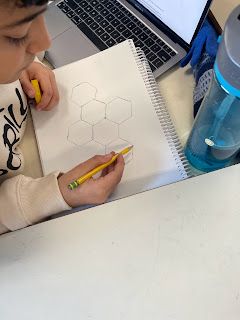I made an attempt at a braided bellringing PH4 poem this week, as discussed in Gerofsky (2020), and really enjoyed the process. Coming up with the four initial words was a little bit tricky, so I just went with what was in front of me - a steaming cup of coffee - something that has been a consistent staple of mine through all the big life changes of the last four years. Reliably and consistently, I can sit at the table and enjoy a cup of coffee every morning.
I loved the interplay of the four words as they weaved through the page, and how I could intersperse punctuation or emphasize different words to take different meaning out of each line. Line 6, morning ritual, caffeine-fueled is just slightly different than line 1, caffeine-fueled morning ritual, but gets the exact same point across.
I like the idea of putting something like this on a coffee cup, maybe with some alterations, punctuation, or maybe a different word that works better in certain lines - does anyone have any suggestions? I showed my wife my work as she does sublimation onto ceramic mugs and she said she "didn't get it"... haha.
---
Radakovic and Jagger engage with a poem by Sakaki, which has a structure built around concentric circles and increasing scale (1 - 10 - 100 - 1000 - 10 000). Mathematical poetry is an interesting intersection that I've never explicitly thought of before, but makes total sense. Any time I've examined poetry with my students, our work and attention is rooted in the math of the poem; how many stanzas in this poem? How many syllables in this haiku? Poems are a great way to see the relationship between literary works and math.
The authors recognize an important personal connection between authentic mathematics and poetry. Personal expression, routine, and playing with the words contributed to the authenticity and relatability of the work. This approach challenges the formal approach to poetry interpretation, which allows for a differing perspective on students' work.
I shared some mathematical poetry with my students this week and we had fun picking out the words and phrases that we recognized from math. There was one poem, in particular, that tied together some of our work around fractions, which I'll share here.
At lunchtime, Thomas had to share,
with a friend a juicy pear.
He cut it using extra care,
and left two pieces - that seemed fair.
When he was done, he had to laugh,
now each boy had exactly half.
The next day Thomas went to tea,
with two others - that made three.
They wanted to share evenly,
the biggest sandwich they could see.
It was cut without a word,
and each boy saw they had a third.
Thomas and three friends dropped by,
hungry for a pizza pie.
They decided they would try,
equal pieces for each guy.
Thomas happily reports,
that each boy got a perfect fourth.
- Author unknown
Florian Mass, a data engineer who runs the blog at https://www.fpgmaas.com/ has a series on poetry and data which is fascinating, where he analyzes poetic meter of one of Reddit's "top" poets. Check it out if you're interested!
Question for thought: How might the inclusion of poetry and specifically mathematical poetry impact the teaching of math in a diverse setting?





